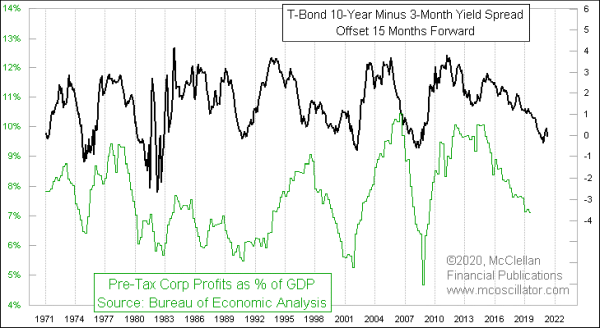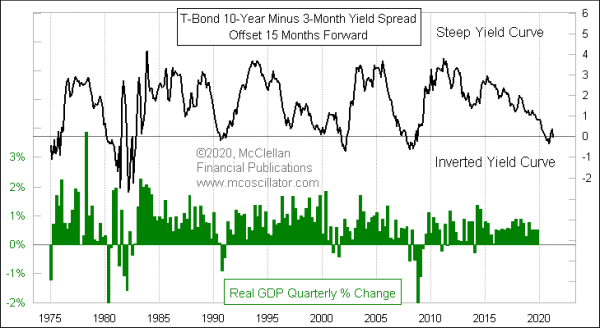
We had an inverted yield curve in 2019, and yet the planet did not tumble off its axis. The sky did not fall. So does that mean an inverted yield curve is not really a problem?
In a word, NO! What the casual armchair economists do not realize about the yield curve is that the effects on the economy of changes in yields are delayed. Generally speaking, it takes about 15 months for those effects to show up in overall economic data.
This week’s chart makes for a great example of this point. It features the spread between the yields on 10-year T-Notes and 3-month T-Bills, and compares that to data on corporate profits. This data on profits is for all U.S. companies, not just those which are publicly traded. It comes from https://apps.bea.gov/iTable/iTable.cfm?reqid=19&step=2, and you then have to go to Table 1.10, line 15. It is worth all of that trouble because this data series on corporate profits arguably gives a better indication of overall U.S. profits than using the SP500 earnings, for example.
To help make the point about the economy lagging the yield curve, I have offset the 10Y-3M spread by 15 months, which allows us to better see how its movements show up again in the corporate profits data. Making this adjustment for the 15-month lag aligns the ups and downs in the two data sets much better. And it allows us to see that we are not yet to the point in time when the 2019 yield curve inversion is going to matter most strongly for the economy.
This 15-month lag is part of the same point I made back on Jan. 23, talking about how Small Cap Underperformance Is Not Over. Small cap stocks tend to be more sensitive to the overall economy’s ups and downs, and so that is why small cap relative performance also lags the 10Y-3M spread by 15 months.
And so does GDP:

The latest data for Q4 2019 real GDP show that it is still at a positive growth rate, and has not gone negative in spite of last year’s yield curve inversion. But remember that the 15-month lag says that GDP should not hit a bottom until 15 months after the most extreme point for this yield spread, meaning sometime in 2020.
In this 2020 election season, we are going to be hearing a lot about the “Trump economy”, with rebuttals saying that it is still really the “Obama economy”. It is neither. Economic growth, or the lack of it, has a lot more to do with the Fed doing the right things with interest rates. And yes, inverting the yield curve is still extremely harmful – – you just have to look in the right place to see where the harm shows up. Last year’s yield curve inversion is still yet to be felt, and that is not even factoring the additional economic slowdown effect from the corona virus.